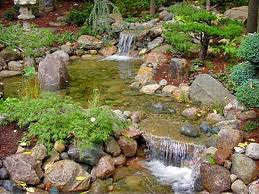A garden water feature like a backyard pond can be an enchanting feature in any garden, big or small. There can be nothing better than sipping a cool drink on a summer's day whilst relaxing next to your own piece of heaven - the tranquility and beauty of your pond and its aquatic life.
A successful pond requires regular maintenance and upkeep to help ensure that fish are happy and healthy and to ensure plants continue to flourish. In winter for example, you need to do safety checks like cutting back folliage, removing fallen leaves, moving smaller fish to aquariums and covering the surface of the pond to protect it from cruel weather conditions. Furthermore, in spring time, it is important to check for fish infections, as a result of coming out of winter dormancy. As temperatures begin to rise towards summer, fish get hungry, which is a great sign, but this increase in appetite can mean increased waste matter in the water, which in turn results in too much ammonia which can be damaging to plants and fish.
Early Springtime is often the most appropriate time to clean out your garden water feature. This way, the pond will have time to revitalize itself in time for the warmer, summer months when the fish are going to be their most active. Ignoring the fact that your pond needs a good clearout can be damaging. After all, during the year sediment will have built up considerably and your pond plants will most likely have grown substantially, leaving less and less room in the water (not to mention oxygen) for other aquatic life.
There may have also been fish infections in the pond that should be completely disinfected before the vibrant summer months. Clearly if you have a preformed unit it may be easier to clean as generally you can take it out of the ground. Even if you don't have aquatic life, giving your garden water feature a spring clean will make it neater and more attractive!
The following 6 steps will help you clean out your backyard pond sufficiently:
1. For those with fish, catch them carefully and transfer to an indoor aquarium or protective environment.
2. Pump out the pond water or bail out the water with a bucket. You should also look to remove any snails or dragonfly larvae as these should not be left behind.
3. Make sure you divide and re-pot marginal plants and waterlilies - these will have overgrown their current pots during the year and their roots will need room to grow further.
4. Remove any silt with a spade - don't waste it, instead try sprinkling it on your flower beds. Also hose out the bottom of the garden water feature.
5. Start to refill the pond with a suitable amount of water conditioner (see product for the required amount).
6. Make sure you let the water temperature rise before adding your fish back to the pond as they may become stressed by the sudden change in temperature (as any human would too!).
2. Pump out the pond water or bail out the water with a bucket. You should also look to remove any snails or dragonfly larvae as these should not be left behind.
3. Make sure you divide and re-pot marginal plants and waterlilies - these will have overgrown their current pots during the year and their roots will need room to grow further.
4. Remove any silt with a spade - don't waste it, instead try sprinkling it on your flower beds. Also hose out the bottom of the garden water feature.
5. Start to refill the pond with a suitable amount of water conditioner (see product for the required amount).
6. Make sure you let the water temperature rise before adding your fish back to the pond as they may become stressed by the sudden change in temperature (as any human would too!).


No comments:
Post a Comment